Holland has an illustrious past and rich history in art, from golden age painters Rembrandt and Vermeer through modernist legends van Gogh, Mondrian and the de Stijl group, Cobra Dutch artists and expatriate Willem de Kooning, to enigmatic Conceptualist Bas Jan Ader, who disappeared in 1970 sailing a small boat across the Atlantic Ocean. Today, there is a thriving art scene centered around Amsterdam, Rotterdam and The Hague, three cities all within less than an hour’s travel from each other in central Netherlands. Exploring this region of the country while on a residency to Kaus Australis in Rotterdam, I became intrigued with the current art being exhibited in this tiny nation; returning recently, the vibrancy and unconventional nature of the scene in central Netherlands seemed a story begging to be told.
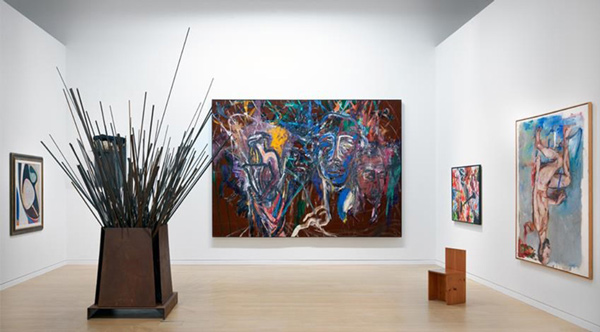
“Excitement” show at the Stedelijk, photo by Gert Jan van Rooij
Amsterdam has long been a destination for those whose joys in traveling centers on viewing art. The Stedelijk, Amsterdam’s modern and contemporary museum, featured a show of note organized by Rudi Fuchs, an unconventional Dutch curator now retired but still active. The exhibition, “Excitement,” featured an eclectic mix of art from the last 30 years, with work from the 1980s heavily represented. In contrast to The Broad in LA, which focuses on much the same period, Fuchs’ choices go more in the direction of Minimalism and Conceptualism rather than neo-pop. With a predilection for work that is both brainy and formally powerful, Fuchs manages to give novel perspectives on this often debased period. Known for his unconventional approach to curating, Fuchs juxtaposes figurative expressionism with reductivist painting and sculpture and idea-based work, creating fresh insights in familiar artworks.

Paul McCarthy public sculpture in Rotterdam.
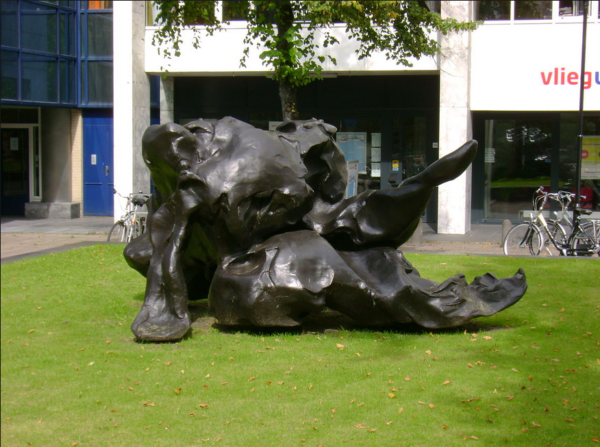
Willem de Kooning public sculpture in Rotterdam.
One of the most impressive aspects of contemporary art in Holland is the copious amount of public art one encounters. Art seems to be everywhere, especially in Rotterdam, from the enormous bronze abstract figures by de Kooning (the sublime) to LA artist Paul McCarthy’s large sculpture entitled Santa Claus (the ridiculous), which has been nicknamed “The Buttplug Gnome” by local residents. Public art is virtually ubiquitous, ranging from rather pedestrian abstract sculptures of modest size to James Turrell’s Celestial Vault (1996) at Kijkduin, a kind of miniature version of the crater bowl of his magnum opus Roden Crater in Arizona. Viewers can experience a reality-changing view of the sky by lying back on one of the concrete beds provided; the impression is that one is sitting in the back of a lens of a giant eyeball open to the beautifully infinite view. The work uses mundane materials (earth and concrete) to create a transcendent experience, placing the view as a conduit between earth and sky.
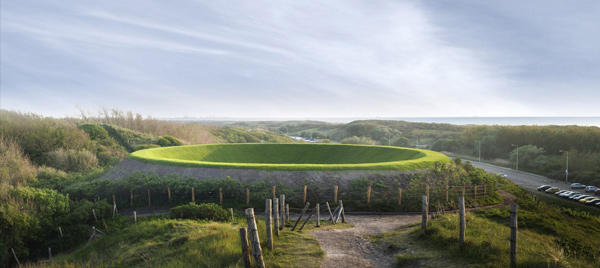
James Turrell, Celestial Vault at Stroom, 1996
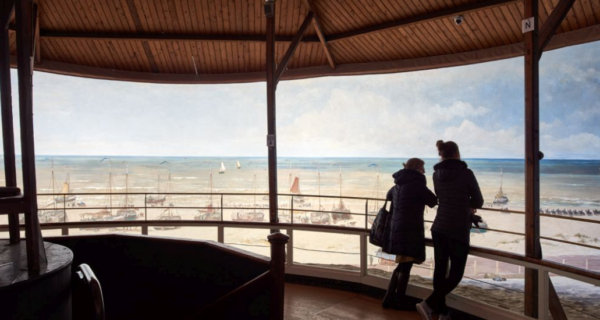
Panorama Mesdag
Not far from the Turrell in the city of The Hague is a 19th-century precursor to Celestial Vault, and to the kind of environmental installation art that has become so prevalent since the late 20th century—the Panorama Mesdag. Painted in 1881 by Dutch painter Hendrik Willem Mesdag, the panorama creates an uncanny illusion of being in the nearby dunes looking out at the ocean by using a combination of a 360-degree mural painting, sand dunes and sculptural objects. Standing on the observation platform, it is easy to imagine you are in the open air, viewing the dunes as they must have appeared in Mesdag’s day. The Museum Mesdag, attached to the panorama, contains Mesdag’s landscape paintings, as well as work by other European artists he collected. Recently, the museum has begun to show contemporary art that relates to the panorama as well; Los Angeles artist Jeremy Kidd’s exhibition of panoramic large-scale photographs is the most recent example. Kidd’s show included a new, massive 10 x 46 foot photograph depicting the same viewpoint Mesdag used in his panorama, and the changes from 1881 to the present day are dramatic.

Jeremy Kidd, Scheveningen Mesdag 1 (installation in The Hague School room at the Panorama Mesdag), archival inkjet print on fabric, 3.08 x 12.76
A few hours travel from The Hague, in the middle of the verdant Hoge Veluwe National Park in Otterlo, lies the Kroller-Muller Museum and Sculpture Garden. At 75 acres, one of the largest sculpture parks in Europe, it features modern and contemporary art in a bucolic forest setting, including some architectural pavilions that showcase smaller sculptures. Of particular note is a massive work by Jean Dubuffet, Jardin d’émail (1974), a singular work in concrete that is a kind of installation art version of his later painted sculptures. The work intrigues because of the way it vacillates between more traditional discrete object sculpture and the notion of sculpture as a complete, immersive environment. One can wander for hours through the garden, which is adjacent to the museum, or explore the national park itself on one of the hundreds of white bicycles provided free. The sculpture collection includes work by such luminaries as Richard Serra, Christo, Lucio Fontana, Mark Di Suvero and many others, while the museum’s immense collection of van Gogh paintings is second in number only to that of the Van Gogh Museum, Amsterdam.

Jean Dubuffet, Jardin d’émail (1974)
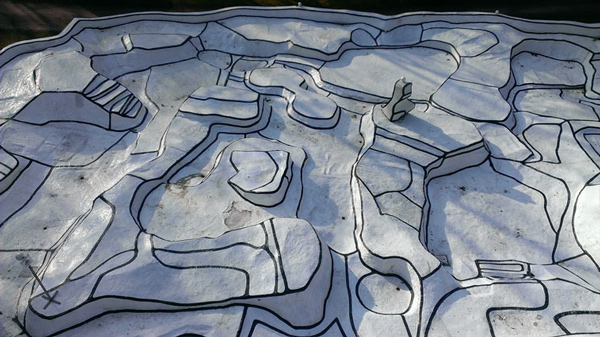
3D scan 2014 (©Fondation-Dubuffet)
One of the most recently opened museums of contemporary art is the Voorlinden, the brainchild of Dutch businessman and collector Joop van Caldenborgh. This privately owned museum in Wassenaar, located in a field bordering a forest, sits on the 98-acre Voorlinden estate, and boasts 22,000 square feet of exhibition space. Designed by Rotterdam-based architecture studio Kraaijvanger, the building is a sleek minimalist edifice, flat-roofed and rectilinear, reminiscent of Mies van der Rohe. The inaugural exhibition was a retrospective of Ellsworth Kelly, and the impressive collection includes Jan Sluijters, Andy Warhol, Rineke Dijkstra, Ron Mueck, Yves Klein, Roni Horn, Richard Serra and Ai Weiwei. It is a real pleasure to view art in such serene surroundings, in the immaculate and understated galleries that underplay the architecture to show the art to greater advantage.

Ewerdt Hilgemann, Three of a kind, 2017.
In addition to the museums mentioned, the Amsterdam/Rotterdam/The Hague region contains many galleries, nonprofits, artist run spaces, and a very active artist community. The Netherlands seems to value contemporary art far more than America does, which is reflected in the presence of public art, the number of museums, and government support of the arts. While truly international in scope, there were several interesting shows of Dutch artists. The Gemeente Museum, The Hague, which has the world’s largest collection of Mondrian paintings, showed the work of Constant Nieuwenhuijs (1920–2005), a Dutch artist who created a fascinating art blending painting, sculpture and architectural models. The extent to which his work reflects the cross-disciplinary nature of today’s art was quite unprecedented at the time. Ewerdt Hilgemann, a German artist who has long resided in the Netherlands, recently showed his “Implosion Sculptures” in Art Zuid in Amsterdam, welded stainless-steel minimalist-like boxes that he reshapes by removing the air inside with a compressor, creating strangely organic, unpredictable forms that are an intriguing conflation of both minimal and post-minimal/process art concerns. Hilgemann recently showed some of these works at Royale Projects in Los Angeles, and actually created new pieces in the gallery, imploding some large sculptures as gallery visitors watched the process with great anticipation. That brings the Netherlands back here to LA, which is where this story ends.


















0 Comments